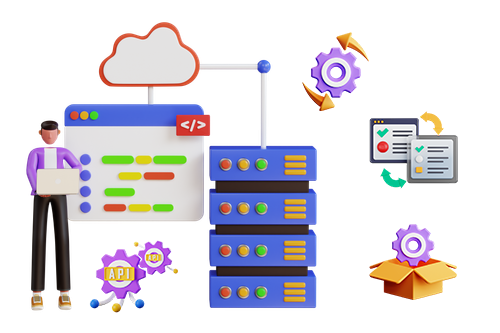What is System Design?
System design is a crucial aspect of building robust, scalable, and efficient systems. It encompasses a broad range of principles, techniques, and concepts, which are fundamental not just for developers but also for enterprise architects. In a world increasingly driven by technology, understanding system design has become a prerequisite for anyone working with complex software or infrastructure. Whether you’re an experienced architect or a developer keen to sharpen your skills, grasping the essentials of system design can significantly enhance your ability to create reliable systems.
System design is the process of defining the architecture, components, interfaces, and data flow of a system to meet specified requirements.
It’s about translating business and technical requirements into a blueprint for creating a system that will perform optimally under various conditions. System design goes beyond simply writing code; it involves high-level thinking and strategic decision-making that will affect the system’s scalability, maintainability, performance, and security.
Why is System Design Important?
- Scalability: A well-designed system can handle increased loads and growth without significant changes to its core architecture. It’s about anticipating future needs and designing the system to grow alongside the business.
- Efficiency: Good system design optimizes resources, reducing waste and maximizing the performance of the system, whether it’s a software application, a cloud infrastructure, or a combination of both.
- Maintainability: Systems need to be adaptable and easy to modify over time. Good design ensures that components are modular, loosely coupled, and well-documented, making future changes more manageable.
- Security: Security must be embedded in the design process. A system’s architecture must safeguard data integrity and prevent unauthorized access, ensuring that security is not an afterthought.
System Design Concepts
Scalability Systems need to scale to handle more data, users, or requests as the business grows. There are two types of scalability:
- Vertical Scalability (Scaling Up): Adding more power (CPU, RAM) to an existing machine.
- Horizontal Scalability (Scaling Out): Adding more machines to distribute the load.
Horizontal scaling is typically preferred in modern architectures, especially with cloud technologies, as it provides better fault tolerance and is more cost-effective in the long term.
Load Balancing Load balancing is a critical concept in ensuring a system’s scalability and availability. It involves distributing incoming network traffic across multiple servers to ensure no single server is overwhelmed. This helps in maintaining performance and reliability even during traffic spikes.
Caching Caching is the practice of storing frequently accessed data in a temporary storage layer, making it quicker to retrieve. For systems that require fast performance (like websites or APIs), caching is a game-changer. Effective caching strategies, such as cache expiration policies and distributed caching, can significantly improve the user experience and reduce the load on databases.
Database Design and Data Modeling Effective database design underpins a system’s ability to scale and maintain data integrity. A well-designed database structure is essential for both performance and longevity. Techniques such as normalization (to eliminate redundancy) and denormalization (for faster query performance) must be considered based on the use case. Furthermore, choosing the right type of database—relational vs. NoSQL—depends on data access patterns and requirements.
Fault Tolerance and High Availability A robust system is one that can tolerate failures and continue operating smoothly. This is achieved through redundancy, failover mechanisms, and the use of multiple data centers or availability zones. High availability (HA) ensures that the system remains operational even during hardware or software failures.
Event-Driven Architecture Event-driven architecture (EDA) is a pattern where the system reacts to events or changes in state rather than following a predefined sequence of steps. This is especially useful in real-time systems and distributed applications where responsiveness and flexibility are key. Microservices architectures often leverage EDA to decouple services and improve scalability.
Microservices vs. Monolithic Architecture The monolithic approach involves building a single, large application that encompasses all functionalities in one codebase. While simpler to develop initially, it can become difficult to scale and maintain over time.
In contrast, microservices break the system down into smaller, independent services, each responsible for a specific functionality. Microservices allow for independent scaling, easier maintenance, and the flexibility to use different technologies for different services.
Security by Design Security should never be an afterthought. Implementing security from the start (i.e., Security by Design) means considering secure communication protocols, data encryption, and authentication mechanisms in the architecture itself. This proactive approach minimizes vulnerabilities and reduces the risk of breaches.
API Design and Management Well-designed APIs are essential for system integration, especially in modern, distributed systems. Clear API design includes defining endpoints, data structures, and authentication mechanisms. Moreover, tools like API gateways can manage traffic, security, and monitoring of APIs to ensure consistency across services.
System Design Best Practices
- Prioritize Simplicity
- Document Your Design
- Design for Failure
- Keep Users in Mind
- Keep Security in Focus
System design is a critical discipline that requires a balance between addressing the technical intricacies of performance, scalability, and security, while also ensuring that the system aligns with business needs. Seasoned developers and enterprise architects can leverage these concepts to create systems that are resilient, efficient, and ready to evolve with changing demands.
Developers and enterprise architects must master a blend of technical skills, creativity, and problem-solving to design systems that are robust, scalable, and secure.
The beauty of system design lies in its creativity and problem-solving. While the tools and methodologies may evolve over time, the foundational principles of system design remain steadfast. Whether you’re designing a monolithic application or a distributed microservices architecture, these core principles will guide your decisions and empower you to build systems that stand the test of time.



